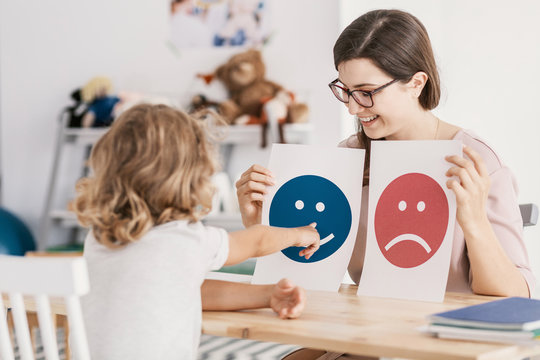7 Best Strategies for Boosting Autistic Childrens Emotional Intelligence
Boost your autistic child’s emotional intelligence by using visual aids for understanding emotions and practicing relaxation techniques like deep breathing. Implement structured routines for predictability and consider seeking professional support or therapy. Encourage social skills development and self-expression through art and music. Enhance emotional vocabulary and recognition with activities like emotion recognition and regulation techniques. These strategies can help your child thrive emotionally and socially.
Key Takeaways
- Utilize visual aids like emotion charts for better understanding.
- Practice mindfulness with breathing exercises and sensory activities.
- Maintain structured routines and schedules for predictability.
- Seek professional support such as play therapy and CBT.
- Engage in family counseling and group sessions for social interaction.
Understanding Emotions Through Visuals

To help your autistic child better understand emotions, consider using visual aids such as picture cards and emotion charts. Visual emotion cards can be a pivotal tool in aiding your child’s comprehension of different feelings. These cards depict various emotions like happiness, sadness, anger, and confusion through images, making it easier for your child to identify and associate each emotion with its corresponding visual representation.
Engaging in emotion recognition activities can also be beneficial. Try showing your child pictures of people displaying different emotions and ask them to identify what the person might be feeling. This activity helps your child practice recognizing emotions in others, which is an essential aspect of emotional intelligence.
Practicing Mindfulness and Relaxation Techniques
Let’s explore some valuable techniques for helping your autistic child boost their emotional intelligence.
Breathing exercises can aid in relaxation, while engaging in mindful sensory activities can enhance their awareness and emotional understanding.
Additionally, practicing emotional regulation techniques can empower your child to better manage their feelings in various situations.
Breathing Exercises for Relaxation
Engage your child in simple breathing exercises to promote relaxation and practice mindfulness techniques. Deep breathing is a crucial tool to help your child calm their mind and body. Encourage them to take slow, deep breaths in through their nose, hold for a few seconds, and then exhale slowly through their mouth. This technique can be particularly beneficial during moments of stress or overwhelm.
Relaxation exercises can also play an essential role in helping your child build emotional intelligence. Teach them progressive muscle relaxation by tensing and then relaxing different muscle groups in their body. This exercise can help your child become more aware of physical tension and learn to release it consciously.
Mindful Sensory Activities
Encouraging your child to participate in mindful sensory activities can be a valuable way to practice relaxation techniques and enhance their mindfulness skills. Engaging in sensory exploration through activities like playing with textured materials, listening to calming sounds, or focusing on different scents can help your child develop sensory awareness and regulate their emotions effectively.
Mindfulness activities such as guided imagery, progressive muscle relaxation, or deep breathing exercises can also aid in calming techniques. By incorporating these practices into your child’s routine, you can provide them with tools to manage stress and anxiety more efficiently. Encouraging your child to be present in the moment and pay attention to their senses can improve their ability to self-soothe and cope with overwhelming feelings.
Remember to create a safe and comfortable environment for these activities, allowing your child to fully immerse themselves in the sensory experience. With consistent practice, mindful sensory activities can become a beneficial part of your child’s emotional intelligence development.
Emotional Regulation Techniques
To enhance your child’s emotional regulation skills, incorporating mindfulness and relaxation techniques into their daily routine can be highly beneficial. By introducing coping strategies like cognitive restructuring and emotional processing, you can help your child develop the tools needed to navigate and regulate their emotions effectively.
Mindfulness practices can assist in increasing self-awareness and promoting emotional regulation by encouraging your child to stay present in the moment and acknowledge their feelings without judgment.
Engaging in relaxation techniques such as deep breathing exercises or progressive muscle relaxation can help your child calm their mind and body during moments of heightened emotions. These practices can serve as valuable tools for your child to manage stress and anxiety, fostering a sense of emotional well-being.
Encouraging Social Skills Development

Developing social skills in autistic children requires consistent practice and patience from caregivers and educators alike. Utilizing play therapy can be an effective way to help children with autism enhance their social interactions in a natural and enjoyable setting. Through play therapy, children can learn important skills such as turn-taking, sharing, and communication, all while having fun.
Another helpful strategy is using social stories, which are short narratives that depict social situations and appropriate responses. These stories can help autistic children better understand social cues and expectations, improving their social skills in various contexts. Caregivers and educators can create personalized social stories tailored to the child’s specific needs and challenges.
Promoting Self-Expression Through Art and Music
Utilize creative outlets such as art and music to help autistic children express themselves and cultivate their emotional intelligence in a meaningful way. Creative exploration through art therapy allows children to communicate thoughts and feelings that they may struggle to express verbally.
Engaging in art activities can provide a safe space for emotional expression and self-discovery. Encourage your child to experiment with different art mediums, colors, and techniques to find what resonates with them the most.
Music therapy is another powerful tool for promoting self-expression and emotional development in autistic children. Listening to music, playing instruments, or creating melodies can be a non-verbal way for children to convey their emotions and connect with others.
Incorporating music into daily routines can help regulate emotions and reduce anxiety.
Building Emotional Vocabulary and Recognition
You can help your child expand their emotional vocabulary by introducing new words to describe feelings and emotions.
By doing so, you provide them with a more nuanced understanding of their own and others’ emotions.
This can enhance their ability to recognize and express their feelings effectively.

Vocabulary Development
Enhancing your child’s emotional intelligence starts with expanding their emotional vocabulary and recognition skills. One effective way to do this is through word association. Encourage your child to associate specific emotions with corresponding words.
For example, when your child feels happy, introduce the word ‘joy’ or ‘excitement’ to help them label and understand their emotions better.
Storytelling techniques can also be incredibly beneficial in vocabulary development. Create stories or use books that highlight different emotions and their causes. By immersing your child in these narratives, they can learn to identify and express a wider range of feelings.
Additionally, storytelling can make emotional concepts more relatable and easier to grasp for autistic children.
Emotion Recognition
Developing emotional vocabulary and recognition skills is essential for enhancing autistic children’s emotional intelligence. Building emotional literacy involves teaching children to identify and understand their own emotions and those of others.
Role-playing scenarios can be a valuable tool in helping autistic children recognize different emotions and learn appropriate responses. By acting out various emotional situations, children can practice identifying facial expressions, body language, and tone of voice that correspond to specific feelings.
Additionally, social stories can aid in teaching emotional cues and responses. These stories present social situations in a structured and consistent manner, helping children with autism learn how to interpret and react to different emotions they may encounter. Through these narratives, children can gain a better understanding of the feelings of others and how to appropriately express their own emotions.
Implementing Structured Routines and Schedules
Establishing consistent and structured routines and schedules can greatly benefit autistic children in developing a sense of predictability and security in their daily lives. Time management plays an important role in creating a framework that helps children navigate their day more smoothly. By incorporating daily routines, such as consistent mealtimes, bedtime rituals, and designated times for activities like play or learning, you can provide a structured environment that supports their emotional well-being.
Daily routines offer a sense of stability and familiarity, which can be especially comforting for autistic children who thrive on predictability. Having a set schedule can also help in reducing anxiety and meltdowns by offering a clear outline of what to expect throughout the day. It’s essential to communicate these routines effectively, using visual aids or schedules, to help them understand and follow along.
Incorporating structured routines and schedules into your child’s daily life can foster a sense of security, improve time management skills, and promote emotional regulation. By creating a consistent and predictable environment, you’re supporting their emotional development in a meaningful way.
Seeking Professional Support and Therapy

To further support your autistic child’s emotional development, consider seeking professional support and therapy to provide them with specialized guidance and assistance.
Play therapy can be a valuable tool in helping your child express themselves in a safe and supportive environment. Through play, they can learn to navigate their emotions and develop essential social skills.
Cognitive Behavioral Therapy (CBT) is another effective approach that can assist your child in understanding and managing their feelings and behaviors.
Family counseling is essential for creating a strong support system for your child. It can help improve communication within the family, enhance understanding of autism, and provide strategies for better coping mechanisms.
Group sessions can also be beneficial, allowing your child to interact with peers in a structured setting.
Frequently Asked Questions
How Can I Adapt These Strategies for Non-Verbal Autistic Children?
You can adapt strategies for non-verbal autistic children by prioritizing non-verbal communication through sensory tools. Utilize visual cues and incorporate movement activities to facilitate understanding and emotional expression. These tools can help foster connection and growth.
Are There Specific Techniques for Helping With Sensory Overload?
When dealing with sensory overload, try sensory integration techniques and coping mechanisms. Make environmental modifications and teach relaxation techniques. These strategies can help manage overwhelming stimuli and create a more calming environment for autistic individuals.
Can These Strategies Be Effective for Teenagers With Autism?
Yes, these strategies can be effective for teenagers with autism. Helping with teenage independence, social skills, self-regulation, and coping mechanisms is essential. By providing support and teaching valuable skills, you can empower them to navigate challenges successfully.
What Role Can Parents Play in Supporting Emotional Development?
As a parent, you play a vital role in supporting your child’s emotional development. By actively engaging in their therapy support and encouraging social skills, you can positively impact their cognitive development and overall well-being.
How Do I Handle Setbacks or Resistance to These Strategies?
When setbacks arise with supporting emotional development in autistic children, remember to build resilience by offering unwavering support. If facing resistance, manage frustration calmly and seek alternative strategies that cater to their unique needs and preferences.
Conclusion
To sum up, by incorporating these strategies into your daily routine, you can help boost your autistic child’s emotional intelligence and overall well-being. Remember to be patient, consistent, and supportive as you navigate this journey together.
With understanding, practice, and guidance, you can empower your child to navigate their emotions effectively and thrive in their unique way. Keep up the great work and don’t hesitate to seek professional support when needed. You’re doing an amazing job!

Hey there! 👋 I’m a proud mom and passionate writer, sharing my parenting journey. 📝 Join me as I navigate the ups and downs of motherhood, offering tips, advice, and a sprinkle of humor along the way. 🌟







